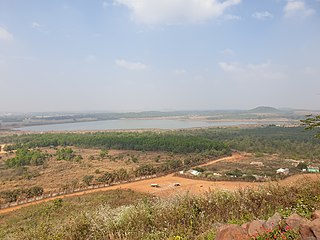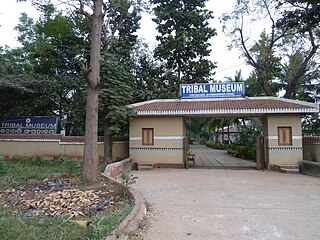
The Munda languages are a group of closely related languages spoken by about nine million people in India, Bangladesh and Nepal. Historically, they have been called the Kolarian languages. They constitute a branch of the Austroasiatic language family, which means they are more distantly related to languages such as the Mon and Khmer languages, to Vietnamese, as well as to minority languages in Thailand and Laos and the minority Mangic languages of South China. Bhumij, Ho, Mundari, and Santali are notable Munda languages.

Koraput district is a district of India in southern Odisha, with headquarters at Koraput. The district is located in the Eastern Ghats and is known for its hilly terrain, rich and diverse types of mineral deposits and its tribal culture and traditions. The district headquarters town of Koraput and its largest city, Jeypore are major centres of trade and commerce for South Odisha and fall on an important road connecting Visakhapatnam to Raipur.

Nabarangpur district, also known as Nabarangapur district or Nawarangpur district, is a district of Odisha, India. The city of Nabarangpur is the district capital. Most of its population is tribal and the land is heavily forested. It borders Kalahandi and Koraput districts. Nabarangpur district is situated at 19.14′ latitude and 82.32′ longitude at an average elevation of 572 metres (1,877 ft).

Kandhamal district also known as Phulbani district is a district in the state of Odisha, India. The District headquarters of the district is Phulbani. It is a district full with natural beauties includes wild animals and birds.
The tribes of Jharkhand consist of 32 scheduled tribes inhabiting the Jharkhand state in India. In 1872, only 18 tribes were counted among the scheduled tribes from which Banjara, Bhatudi, Chik Baraik, and Mahli were marked as semi-Hindu aboriginal and Kora as proletariat Hindu. In the 1931 census, including the above four semi-Hindu aboriginal and Kora, a proletariat Hindu, the number was raised to 26 from 18. They were Birajia, Godait, Karmali and Paharia, but Kisan was excluded from the list. In the 1941 census, Baga, Bedia and Lohra were included again taking Kisan in the annexure and the number came to 30 which prevailed till June 2003. Kanwar and Kol were added on 8 June 2003 in the annexure and the number of Schedule Tribes came to 32.

Khonds are an indigenous Adivasi tribal community in India. Traditionally hunter-gatherers, they are divided into the hill-dwelling Khonds and plain-dwelling Khonds for census purposes, but the Khonds themselves identify by their specific clans. Khonds usually hold large tracts of fertile land, but still practice hunting, gathering, and slash-and-burn agriculture in the forests as a symbol of their connection to, and as an assertion of their ownership of the forests wherein they dwell. Khonds speak the Kui language and write it in the Odia script.
The Tea-garden community is a term for a multiethnic, multicultural group of tea garden workers and their descendants in Assam. They are officially referred to as Tea-tribes by the government of Assam and notified as Other Backward Classes (OBC). They are the descendants of peoples from multiple tribal and caste groups brought by the British colonial planters as indentured labourers from the regions of present-day Jharkhand, Odisha, Chhattisgarh, West Bengal and Andhra Pradesh into colonial Assam during the 1860-90s in multiple phases to work in tea gardens. They are found mainly in those districts of Upper Assam and Northern Brahmaputra belt where there is a high concentration of tea gardens, like Kokrajhar, Udalguri, Sonitpur, Biswanath,Nagaon, Golaghat, Jorhat, Sivasagar, Charaideo, Dibrugarh, Tinsukia, and Lakhimpur. There is a sizeable population of the community in the Barak Valley region of Assam as well in the districts of Cachar, Karimganj and Hailakandi. The total population is estimated to be around 7 million, of which an estimated 4.5 million reside in residential quarters built inside 799 tea estates spread across tea-growing regions of Assam. Another 2.5 million reside in the nearby villages spread across those tea-growing regions. They speak multiple languages, including Sora, Odia, Assam Sadri, Sambalpuri, Kurmali, Santali, Kurukh, Kharia, Kui, Chhattisgarhi, Gondi and Mundari. Assam Sadri, distinguished from the Sadri language, serves as lingua franca among the community.

Kendujhar District, is an administrative district of Odisha. The district is one of the fifth Scheduled Areas of Odisha. The town of Kendujhar is the district headquarters. The district has three sub-divisions, Anandapur, Champua, and Kendujhar.
Halba are a tribal community found in Chhattisgarh, Maharashtra, Madhya Pradesh and Odisha in India. They speak the Halbi language. They are primarily agricultural community. Halbas are mixed tribes or tribal caste, descended from the unions of Gonds and Hindus. Linguistic evidence also points to the fact that the Halbas are an aboriginal tribe, who have adopted Hinduism and an Indo-European language. They were cultivators and farm servants whose home is the south of the Raipur District and the Kanker and Bastar States; from here small numbers of them have spread to Bhandara, parts of Berar and also into Koraput in Odisha.

There are 46 recognized Scheduled Tribes in Madhya Pradesh, India, three of which have been identified as "Particularly Vulnerable Tribal Groups" or "PTGs". The population of Scheduled Tribals (ST) is 21.1 per cent of the state population, according to the 2011 census. Bounded by the Narmada River to the north and the Godavari River to the southeast, tribal peoples occupy the slopes of the region's mountains.

Bhumij is a Munda ethnic group of India. They primarily live in the Indian states of West Bengal, Odisha, Assam and Jharkhand, mostly in the old Singhbhum district. Also in states like Bihar and Assam. There is also a sizeable population found in Bangladesh. Bhumijas speak the Bhumij language, an Austroasiatic language, and use Ol Onal script for writing.
Scheduled Tribes are specific indigenous peoples whose status is acknowledged to some formal degree by national legislation. Scheduled tribes of the Indian state of West Bengal, as recognized by the Constitution of the Indian Republic; a total of 40 distinct tribes. Among those 40 tribes 3 tribes are "Particularly Vulnerable Tribal Groups" (PTGs).
Below is given a chronological record of tribal and peasant revolts in India before independence from British rule in the 1947. The list covers those tribal uprisings that occurred during the period of British rule in India.

The Munda peoples of eastern and central parts of the Indian subcontinent are any of several Munda speaking ethno-linguistic groups of Austro-asiatic language family, formerly also known as Kolarian, and spoken by about nine million people.
Kolarian is a word first used by George Campbell for Munda languages. He described it as one of the three non-Aryan language families of India, which he made up, along with the Tibeto-Burman and the Dravidian. It is a branch of Austro-asiatic languages spoken in the eastern regions of the subcontinent, and is also known as Munda languages. Its not a single tribal language but a group of tribal family languages. The speakers are called Kolarian tribes.

Tribal Research Institute Museum, Museum of Tribal Arts and Artifacts, is a museum in Bhubaneswar, Odisha inside the campus of Scheduled Castes & Scheduled Tribes Research & Training Institute. It is popularly known as Tribal Museum and conceptually labeled as Museum of Man. It has life-sized authentic tribal dwellings, created by the tribal craftsmen offers a view of the State's tribal heritage. It has sections which showcase tribal artifacts and objects, focusing on well researched, documented cultural life of tribals of Odisha. It is headed by a Director, who is in the rank of a University Professor, and the administrative control lies in the hands of ST, SC, Minorities, and Backward Classes Welfare Department, Government of Odisha.

Sarnaism is a religious faith of the Indian subcontinent, predominantly followed by indigenous communities in the Chota Nagpur Plateau region across states like Jharkhand, Odisha, West Bengal, Bihar, and Chhattisgarh. This belief centers around the reverence of Sarna, the sacred groves of village communities where the village deity, known as Gram deoti resides, and where sacrificial offerings are made twice a year. It is also referred to as "Sarna Dharma" or the "Religion of the Holy Woods", and it holds the distinction of being India's largest tribal religion.
Kandha Gauda, is a cattle herding tribal community of Odisha. They communicate within their group using the Kui language and use Odia for interaction with society.





















